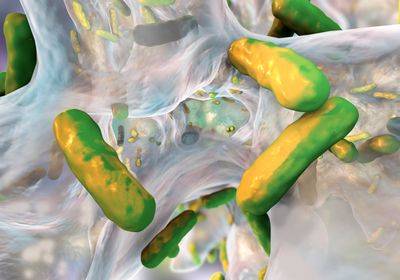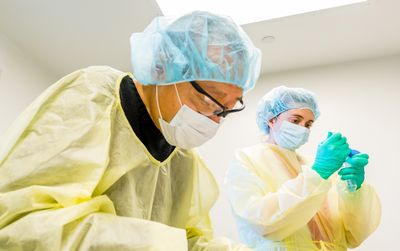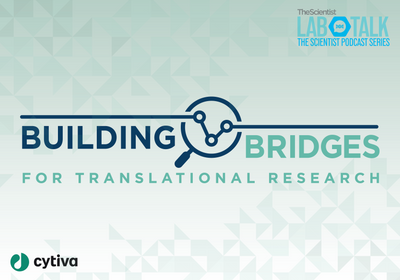ABOVE: © ISTOCK.COM, DR_MICROBE
Mycoplasma pneumoniae are tiny bacteria typically known to cause lung infections. But now, a group of scientists have turned them into double agents. Genetically engineered Mycoplasma helped break down biofilms of another pathogenic microbe, Pseudomonas aeruginosa, in a mouse model of ventilator-associated pneumonia and on tube samples taken from human patients, the team reported January 19 in Nature Biotechnology. It is one of the first times that scientists have used live bacteria to treat a lung disease, and is the first therapeutic use of Mycoplasma.
“This approach is really powerful,” says Dave Hava, a microbiologist who wasn’t involved in the research, but who works at a company called Synlogic that develops live bacteria therapeutics for gut issues. “It offers the chance to target diseases and mechanisms that you can’t do with conventional therapies.”
When harmful bacteria invade our bodies, they can sometimes take up residence in the form of a biofilm: a three-dimensional, complex community usually adhered to some crevice in the body, such as the surface of a lung or a section of a catheter. Because of their complicated structure, biofilms are often resistant to antimicrobial treatments even when the individual bacteria in the film are not, forcing scientists to look for alternative means of treating the infection. Live bacteria have recently emerged as a promising option, according to Hava: Because they are living organisms, these bacteria can not only perform more complicated functions than small molecules—including synthesizing enzymes and other proteins—they can also be engineered to produce sundry proteins at once.
Maria Lluch-Senar, a biotechnologist at the University of Catalonia as well as the founder and chief scientific officer of the company Pulmobiotics, tells The Scientist that she wanted to engineer bacteria that could combat lung diseases, particularly ventilator-associated pneumonia caused by the bacterium Pseudomonas aeruginosa. This type of pneumonia can be particularly dangerous when difficult-to-treat biofilms form. In theory, engineered live bacteria could produce a cocktail of proteins that pokes holes in the biofilm, allowing antibiotics to get through and fight the harmful bacteria. But since the field of bacterial engineering has only taken off in the past few years and is still quite small, Lluch-Senar says no one had yet tried tackling lung diseases.
In science, you never know until you try. After so many years working on this project, this was such a reward.
—Maria Lluch-Senar, Pulmobiotics
Lluch-Senar and her team chose Mycoplasma pneumoniae, a bacteria known for infecting the human respiratory system, for their experiments. Unlike many bacteria, M. pneumoniae cannot recombine, making it a safe candidate for bioengineering that won’t spread its modified genome to other bacteria. It also has a relatively small genome and lacks a cell wall, making it less likely to generate an immune reaction.
The researchers removed the pathogenic genes from M. pneumoniae to ensure the bacteria were safe to use. They then assembled sets of engineered genomes in E. coli, which scientists like Hava use to engineer bacterial treatments for the gut. These genomes contained a one-two punch to tackle the biofilm: a genetic cassette that codes for the production of biofilm-breaking enzymes and the gene for a toxin that can kill P. aeruginosa. They then transferred the genes in the form of isolated DNA to M. pneumoniae. The process was tedious; M. pneumoniae grows slowly, which made adding tweaks to the experiments an overly drawn-out process. However, after many years of testing, Lluch-Senar and her team felt confident enough to try their new bacteria on mice.
After infecting the mice with P. aeruginosa, the scientists gave some of the mice the modified M. pneumoniae bacteria and left other mice with no treatment. The treatment helped: The mice given the engineered bacteria treatment had significantly milder lesions on their lungs after two days and survived an average of seven days post infection, whereas mice given no treatment had more severe lesions and survived an average of two days post infection. The team also tested their bacteria on biofilm-covered endotracheal tubes taken from ventilator-associated pneumonia patients. After just 24 hours, tubes treated with the engineered bacteria had lower P. aeruginosa loads than tubes treated with antibiotics alone or left untreated.
Although the engineered bacteria weren’t a total cure, Lluch-Senar says she couldn’t have been happier with the results. “In science, you never know until you try,” she says. “After so many years working on this project, this was such a reward.”
Going forward, Lluch-Senar wants to take her bacteria into the clinical space, where she hopes one day they can treat human pneumonia. Hava says he is looking forward to it and is excited about the new bacteria’s other potential uses. “I’d be really interested to see what other diseases could benefit from this approach,” he says. “If this [study] is the new platform, how can that platform be used more broadly?”
Lluch-Senar agrees, saying she is planning on applying their new engineering techniques to other lung diseases such as lung cancer and asthma. “We want to bring these solutions to society, to people,” she says. “That is why I decided to do what I do.”







